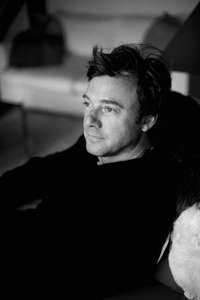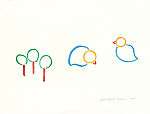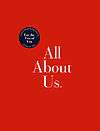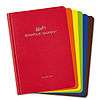Philipp Keel
Philipp Keel is an artist, writer and publisher based in Zurich, Switzerland and Los Angeles, California.
Philipp Keel | |
|---|---|
 | |
| Born | Zurich, Switzerland |
| Nationality | Swiss |
| Education | Berklee College of Music Boston, MA United States University of Television and Film Munich Germany |
| Known for | Visual art, photography, film, author |
Keel achieved critical and popular acclaim after the best-selling All About Me, a book series with over three million copies in print. Central to his work are caricature, the beauty of details, light, and the complexity of the human mind. Noted for pioneering the Imbue Print technique, Keel received recognition in the art world with a solo show at Art Basel in 2001. Two years later, Steidl Publishing released Color, the most comprehensive collection of his editions.
Keel draws inspiration from Keith Jarrett's The Köln Concert, palm trees, the short stories of Carson McCullers, David Hockney's Paper Pools, rabbits, and Coca-Cola in the classic 237 ml glass bottle.
Early years
Philipp Keel was born and grew up in Zurich, Switzerland. His father is Daniel Keel, founder of Diogenes Verlag, and his mother, Anna Keel, is a painter and sculptor. Frequent guests in the Keel household included Patricia Highsmith, Maurice Sendak and Federico Fellini, whom Philipp delighted in watching direct movies at Cinecittà in Rome. At age nine, while in the hospital recovering from a near-fatal car accident, Keel decided he would become an artist and film director.
The younger of two sons, Keel, though lively and curious at home,[1] was shy and inattentive at school. As early as kindergarten, he found himself more captivated with toys and books than with games or lessons. Diane Arbus’ photographs featured frequently in his imagination. When Keel was fourteen years old, he literally escaped from boarding school in Gruyère and used his birthday money to take a train to Paris. It was during this sojourn that he discovered a passion for photographing people and mysterious details, using a camera he found in a park. At the same time, Keel began to make drawings and caricatures inspired by the works of Tomi Ungerer, Saul Steinberg and Sempé.
Career



After studying improvisational piano at Berklee College of Music in Boston, Keel returned to Switzerland to work for ad agency Ogilvy & Mather, where he wrote campaigns for clients such as Ford, Pepsi, and Polaroid before going on to direct radio and television commercials. At twenty-one, Keel founded his own advertising agency in a tiny two-room apartment above a fish market and over the next few years used his earnings to develop his skills as an artist.
In 1992 Keel moved to Minneapolis, where he met John Dunkley, a Native American of the Ojibwe Tribe. The two became friends, and Keel was inspired with the idea for a docudrama about a Swiss man who decides to explore living in the poorest county in the United States. Keel moved onto the Pine Ridge Reservation in the Badlands, South Dakota. There, with the help of the Oglala Sioux, he completed the film under the influence of fluid morphine, which had been prescribed for a dislocated shoulder he suffered during a basketball game at a local orphanage. Greetings From Pine Ridge marked his first directorial turn.
That autumn, Keel started studying at University of Television and Film (formerly: HFF), Munich. Upon graduation three years later, Keel moved to Los Angeles. The city, in the aftermath of the Rodney King riots and the Northridge earthquake, was cheap and relatively empty. Keel wrote a few scripts and continued making art, but soon found himself overwhelmed and broke. Inspired by his observation that the privilege of talking about oneself seems to be reserved for famous people, Keel wrote All About Me,[2] a candid questionnaire in twenty-five chapters about life and love, designed to help readers deepen their understanding of themselves. With over three million copies in print worldwide, other books in the All About series include All About Us,[3] and All About Me – The Teenage Edition.[4]
Keel dedicated the next decade to his art. During this period, Keel's paintings and photography were exhibited in established galleries and museums throughout Europe and the United States. Speaking in an interview about his greatest influences he said, "As strange as it might seem, most of my inspiration comes from Los Angeles. You may find its irony, sadness, its absurd beauty and childish naïveté in my entire body of work. Here is where I think I will always create something new again and force myself to overcome the fear of trying something that I would be afraid of exploring in other hemispheres.”
It was only after relocating to California that Keel started photographing in color, and that he discovered painting and printmaking. He collaborated with Don Weinstein, a printer who has worked with artists like Annie Leibovitz, Richard Avedon, and Helmut Newton, and who invited him to experiment with archival inks. A solo show at the Galerie zur Stockeregg marked Keel as the first artist to exhibit large-scale Imbue Prints. In a move toward closure with a chapter of his career, Keel undertook the task of editing and cataloging his entire black-and-white photography archives. The result was his first art publication, Look at Me.[5] His next art book, Color,[6] was released three years later, followed by AISA – Images from an Imaginary Continent[7] in 2005.
His most recent publication, Keel's Simple Diary,[8] "challenges the constant barrage of information, the struggle of needing to do more while having time for less, and the wonderful demands of modern life." The books provide amusing and philosophical insights into the world and the human mind, prompting the reader to contribute their own thoughts. Simple Diary is Taschen's first publication primarily filled with text.
Keel rejects what he refers to as "cynicism in the contemporary art world" and has reservations about work that is overly political. "When style and light meet, there is art. Art doesn't need to be invented, art is what has already been set up. It is not an artist's responsibility to capture what is there, it should be an artist's challenge to exaggerate or diminish what already exists."[6]:8
References
- Die Welt, Hamburg, 29 April 2000, Page 2 Fast alles über P. Wie der Verlegersohn Philipp Keel mit Fragenkatalogen Karriere machte
- Keel, P. (1998) All About Me. Broadway Books. ISBN 0-7679-0205-X
- Keel, P. (2000) All About Us. Broadway Books. ISBN 0-7679-0501-6
- Keel, P. (2004) All About Me Teenage Edition. Broadway Books. ISBN 0-7679-1495-3
- Keel, P. (1999) Look at Me. Stemmle. ISBN 3-908161-14-2
- Keel, P. (2003) Color. Steidl. ISBN 3-88243-865-7
- Keel, P. (2005) AISA – Images From An Imaginary Continent. Edition Judin. ISBN 3-906801-04-7
- Keel, P. (2009) Simple Diary. Taschen America LLC. (Royal Blue) ISBN 3-8365-1226-2, (Red) ISBN 3-8365-1678-0, (Orange) ISBN 3-8365-1679-9, (Brown) ISBN 3-8365-1681-0, (Lime Green) ISBN 3-8365-1682-9, (Yellow) ISBN 3-8365-1680-2
Other references
- Neue Zürcher Zeitung, 17 May 2005, Page 36, Section: Zürcher Kultur, Title: Wie wirklich ist die Wirklichkeit?
- NZZ am Sonntag, 2 May 2004, Page 71, Title: Die Welt in Farbe und mit Register
- Süddeutsche Zeitung, 5 March 2004, Page 16, Section: Literatur, Title: Ein Fäustchen für ein Hallelujah
- SonntagsZeitung, 10 June 2001, Page 107, Section: Trend, Title: Ich habe vor Freude aufs Lenkrad getrommelt
- St. Galler Tagblatt, 5 November 2000, Page 24, Section: N/A, Title: Fragen, weil Antworten nicht mehr gefragt sind
- SonntagsZeitung, 19 March 2000, Page 115, Section: Trend, Title: Jungster Philipp Keel: Der Herr der Fragen
- Tages-Anzeiger, 13 November 1999, Page 71, Section: Savoir Vivre, Title: Fragespiel mit ungewissem Ausgang